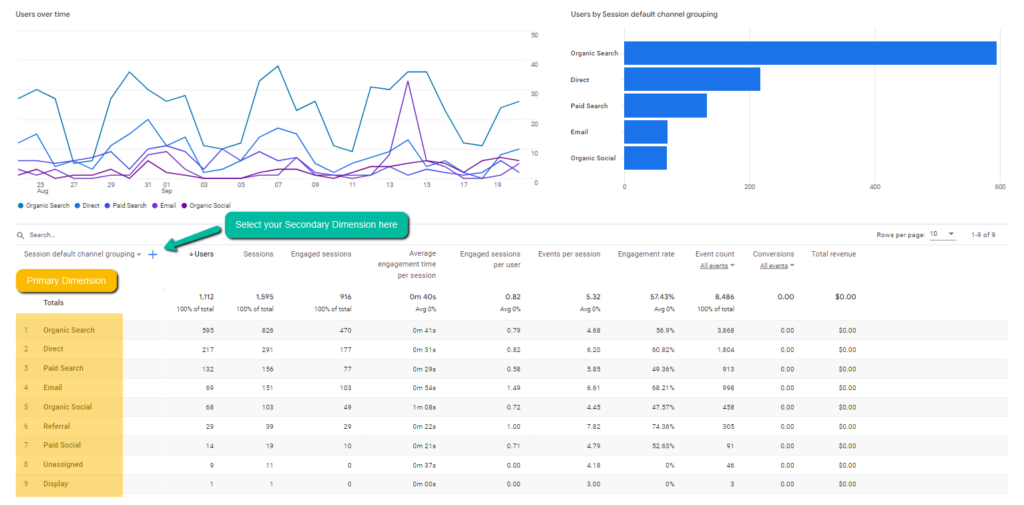Unlock Deeper Insights With Additional Dimension in Google Analytics
With the vast expanse of information offered in Google Analytics, the application of additional dimensions can dramatically enrich your logical capabilities. By purposefully including secondary dimensions into your evaluation, you can uncover beneficial understandings that might or else remain obscure - Secondary Dimension in Google Analytics.
Recognizing Key Vs. Additional Dimensions
When evaluating data in Google Analytics, it is important to compare second and primary dimensions to obtain much deeper understandings right into customer actions. Primary measurements are the main classifications through which you can view your information, such as device, source/medium, or landing page. These measurements give the fundamental framework for arranging and comprehending your data. On the other hand, second measurements permit you to more study your key measurement information. By adding a second measurement, you can layer on extra details to your main dimension, enabling a much more granular analysis. For instance, if your key measurement is the source/medium whereby individuals arrived on your site, including an additional dimension like geographic area can expose where those users are located geographically. This included layer of information can aid you recognize patterns, patterns, or anomalies that might not have actually been evident when considering the main measurement alone. As a result, leveraging both primary and additional measurements in Google Analytics is critical for detailed information analysis and informed decision-making.
Utilizing Secondary Dimensions Effectively
Efficiently using additional dimensions in Google Analytics improves the depth and granularity of data analysis, providing valuable insights into individual actions and fads. By incorporating secondary dimensions alongside key dimensions, analysts and marketing experts can dig deeper right into the specifics of customer interactions on their websites. Second dimensions allow users to sector and filter primary measurement data better, providing a much more in-depth view of individual interactions, habits, and demographics. This can be especially helpful when trying to comprehend the effect of specific variables on customer involvement, such as the devices or browsers they are using, the resources of their web traffic, or their geographical places.
Moreover, additional dimensions allow users to contrast and contrast various information points within a single record, promoting a more thorough evaluation of user actions patterns. By leveraging secondary dimensions efficiently, organizations can uncover covert understandings, optimize their advertising strategies, and improve the total customer experience on their websites.
Discovering Usual Secondary Dimension Mixes
To better evaluate customer behavior and patterns in Google Analytics, it is beneficial to discover common combinations of additional measurements. Some common additional measurement mixes that offer beneficial understandings include assessing traffic sources with customer locations to comprehend where internet site visitors are coming from geographically and exactly how they discovered the site. Taking a look at user actions metrics with secondary measurements such as rate of interests or demographics can assist in targeting details target market sectors extra efficiently.
Using Second Measurement in Custom Reports
Using secondary measurements in personalized reports permits a more thorough analysis of information in Google Analytics, enhancing the deepness of insights gotten. When developing customized reports in Google Analytics, incorporating additional measurements can supply a more thorough sight of exactly how various measurements connect with each various other. click now This function makes it possible for customers to dive deeper right into their data and uncover beneficial relationships that might not be instantly apparent.
By using secondary measurements in personalized reports, users can acquire a better understanding of their internet site or app website traffic. As an example, incorporating the key dimension of "source/medium" with the additional dimension of "touchdown page" can expose which touchdown pages are doing finest for web traffic coming from particular resources. This understanding can aid marketers optimize their campaigns and enhance overall conversion prices.

Enhancing Information Visualization With Additional Measurement
When checking out information in Google Analytics customized reports, including secondary measurements not just provides a much more in-depth evaluation however likewise enhances the aesthetic depiction of insights with information visualization. By including a secondary measurement to your reports, you can enrich the way data exists, making it simpler to determine patterns, patterns, and connections within your website's performance metrics.
Additional measurements can help Full Report you segment your information better, enabling a deeper understanding of customer behavior and interactions on your site. When trying to separate specific variables that might affect your website's performance., this improved degree of granularity can be specifically beneficial.

Verdict
Finally, leveraging secondary measurements in Google Analytics permits for a much more thorough analysis of data, leading to deeper insights and even more enlightened decision-making. Secondary Dimension in Google Analytics. By including added layers of information to main information sets, experts and marketing experts can reveal hidden patterns, patterns, and relationships that give a granular view of user habits and communications. This improved degree of understanding enables optimization of campaigns and tailored methods for specific target market sections, ultimately enhancing performance and conversion prices
On the various other hand, additional pop over to these guys dimensions allow you to additional dissect your primary measurement information. By including a second dimension, you can layer on added information to your main dimension, making it possible for a more granular evaluation. If your primary measurement is the source/medium with which users got here on your website, including an additional dimension like geographical area can reveal where those customers are situated geographically. By including secondary dimensions along with primary dimensions, analysts and marketing professionals can dive deeper into the specifics of individual communications on their internet sites. Secondary measurements enable users to sector and filter main measurement data further, providing a much more in-depth view of individual interactions, demographics, and actions.